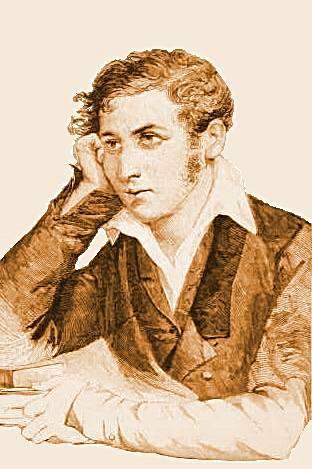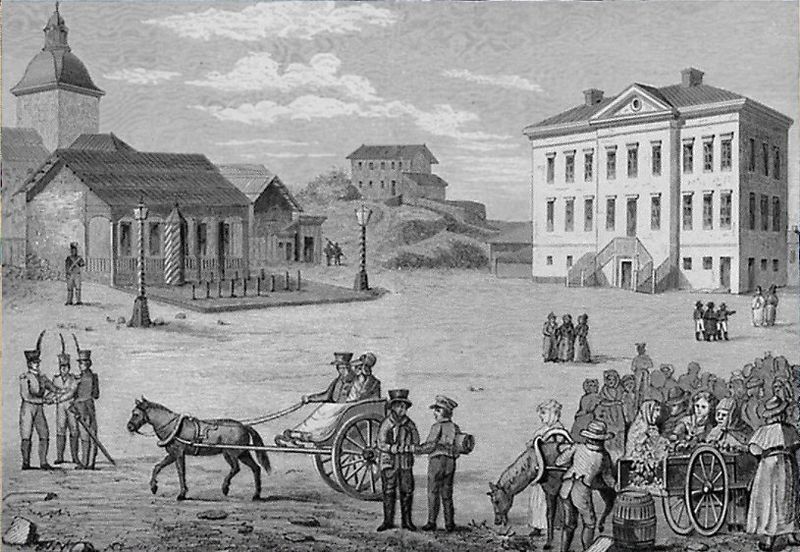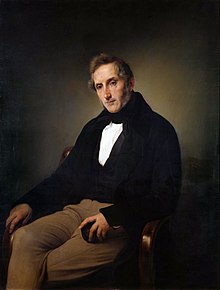Capitulum VI: Sardinia's ideological evolution, Part 1
Territories were not the sole thing that increased during the kingdom of Sardinia's attempt to expand into the Mediterranean and unite Italy. Various ideological thoughts developed in this period, mostly from refugees that wanted to escape their oppressive Hapsbourg dominated territories. We shall look at these that developed from 1836 to 1845:
-Positivism: Positivism is a philosophical theory which states that "genuine" knowledge (knowledge of anything which is not true by definition) is exclusively derived from experience of natural phenomena and their properties and relations. Thus, information derived from sensory experience, as interpreted through reason and logic, forms the exclusive source of all certain knowledge. Positivism therefore holds that all genuine knowledge is a posteriori knowledge. Verified data (positive facts) received from the senses are known as empirical evidence; thus positivism is based on empiricism.
Positivism also holds that society, like the physical world, operates according to general laws. Introspective and intuitive knowledge is rejected, as are metaphysics and theology because metaphysical and theological claims cannot be verified by sense experience. Although the positivist approach has been a recurrent theme in the history of western thought, the modern approach was formulated by the philosopher Auguste Comte in the early 19th century. Comte argued that, much as the physical world operates according to gravity and other absolute laws, so does society.
Positivism asserts that all authentic knowledge allows verification and that all authentic knowledge assumes that the only valid knowledge is scientific. Thinkers such as Henri de Saint-Simon (1760–1825), Pierre-Simon Laplace (1749–1827) and Auguste Comte (1798–1857) believed the scientific method, the circular dependence of theory and observation, must replace metaphysics in the history of thought.[citation needed] Émile Durkheim (1858–1917) reformulated sociological positivism as a foundation of social research.
Wilhelm Dilthey (1833–1911), in contrast, fought strenuously against the assumption that only explanations derived from science are valid. He reprised the argument, already found in Vico, that scientific explanations do not reach the inner nature of phenomena and it is humanistic knowledge that gives us insight into thoughts, feelings and desires. Dilthey was in part influenced by the historicism of Leopold von Ranke (1795–1886).
A connection between modernity and positivism developed in Sardinia with its first philosopher, Carlo Cattaneo.
Born in Milan, son of Melchiorre, a goldsmith who came from Val Brembana, and of Maria Antonia Sangiorgio, Carlo spent most of his childhood dividing himself between Milanese city life and long and frequent stays in Casorate, where he was often a guest of old relatives. It was during these stays that, taking advantage of the library of his great-uncle Giacomo Antonio, a country priest, Cattaneo became passionate about reading, especially the classics.
His love for classical literature led him to undertake studies in the seminaries of Lecco first and then Monza, which should have led him to an ecclesiastical career, but already at the age of seventeen, he left the seminary to continue his training at the Sant 'Alessandro in Milan and later at the high school of Porta Nuova where he graduated in 1820. His cultural and intellectual training was shaped, during his higher studies, by masters such as Giambattista De Cristoforis and Giovanni Gherardini, who opened the doors of the world to him Milanese intellectual. Thanks to these new opportunities, in addition to his passion for classical studies, Cattaneo began to nurture interests of a scientific and historical nature.
Carlo Cattaneo in his younger years
During this period the readings at the Brera Library and the contact with his paternal cousin Gaetano Cattaneo were fundamental for his intellectual formation, who, in addition to being director of the numismatic cabinet, was also an important exponent of the early Milanese intellectual world. century. Another key point for the formative path of Cattaneo's interests was the assiduous attendance of the Ambrosiana Library, thanks to his maternal kinship with the prefect Pietro Cighera, and the personal library of his paternal uncle Antonio Cattaneo, pharmacist and chemistry scholar.
In December 1820, the Municipal Congregation of Milan hired him as a teacher of Latin grammar and then of human sciences in the municipal gymnasium of Santa Marta where he remained for fifteen years. In this same period he began to deepen his acquaintances with the Milanese intellectuals, becoming part of the circle of Vincenzo Monti and his daughter Costanza, of these same years are his friendships with Stefano Franscini and Giuseppe Montani. After starting to attend the law lessons held by Gian Domenico Romagnosi in his private school, he soon became a friend and pupil. In 1824 he graduated in Law from the University of Pavia with full marks.
Its first publication, given to the press and appeared in the Anthology, dates back to 1822, it is a review of Romagnosi's First Assumption of the Science of Natural Law. Between 1823 and 1824 he was absent numerous times from his teaching post due to illness, probably due to severe rheumatism. Between 1824 and 1826 he published his translations from German of popular historical and geographical works, the result of a government commission. During this period he collaborated with his friend Stefano Franscini for the translation of Heinrich Zschokke's History of Switzerland for the Swiss People, but which was only published in 1829.
In 1825 his father died and his elder brother Filippo, the eldest son, succeeded him in the goldsmith's shop. In this same year Cattaneo meets Anna Woodcock, a young Anglo-Saxon with whom he will begin to establish an ever deeper relationship.
On July 08 1838, because of possible Austrian suspects of Cattaneo's collaboration with the Carboneria, he was forced to move into Sardinia, where he become the father of positivism not only in Sardinia, but also in Italy.
-Functionalism: Functional psychology or functionalism refers to a psychological school of thought that was a direct outgrowth of Darwinian thinking which focuses attention on the utility and purpose of behavior that has been modified over years of human existence. Functionalism denies the principle of introspection, which tends to investigate the inner workings of human thinking rather than understanding the biological processes of the human consciousness.
While functionalism eventually became its own formal school, it built on structuralism's concern for the anatomy of the mind and led to greater concern over the functions of the mind and later to the psychological approach of behaviorism.
This movement has misterious origins in Sardinia, but is believed to have reached the small kingdom on 08 September 1841
-Idealism: In philosophy, idealism is a diverse group of metaphysical views which all assert that "reality" is in some way indistinguishable or inseparable from human perception and/or understanding, that it is in some sense mentally constituted, or that it is otherwise closely connected to ideas. In contemporary scholarship, traditional idealist views are generally divided into two groups. Subjective idealism takes as its starting point that objects only exist to the extent that they are perceived by someone. Objective idealism posits the existence of an objective consciousness which exists before and, in some sense, independently of human consciousness, thereby bringing about the existence of objects independently of human minds. In the early modern period, George Berkeley was often considered the paradigmatic idealist, as he asserted that the essence of objects is to be perceived. By contrast, Immanuel Kant, a pioneer of modern idealist thought, held that his version of idealism does “not concern the existence of things”, but asserts only that our “modes of representation” of them, above all space and time, are not “determinations that belong to things in themselves” but essential features of our own minds. Kant called this position “transcendental idealism” (or sometimes “critical idealism"), holding that the objects of experience relied for their existence on the mind, and that the way that things in themselves are outside of our experience cannot be thought without applying the categories which structure all of our experiences. However, since Kant's view affirms the existence of some things independently of experience (namely, "things in themselves"), it is very different from the more traditional idealism of Berkeley.
Epistemologically, idealism is accompanied by skepticism about the possibility of knowing any mind-independent thing. In its ontological commitments, idealism goes further, asserting that all entities rely for their existence on the mind. Ontological idealism thus rejects both physicalist and dualist views as failing to ascribe ontological priority to the mind. In contrast to materialism, idealism asserts the primacy of consciousness as the origin and prerequisite of phenomena. Idealism holds consciousness or mind to be the "origin" of the material world – in the sense that it is a necessary condition for our positing of a material world – and it aims to explain the existing world according to these principles. The earliest extant arguments that the world of experience is grounded in the mental derive from India and Greece. The Hindu idealists in India and the Greek neoplatonists gave panentheistic arguments for an all-pervading consciousness as the ground or true nature of reality. In contrast, the Yogācāra school, which arose within Mahayana Buddhism in India in the 4th century CE, based its "mind-only" idealism to a greater extent on phenomenological analyses of personal experience. This turn toward the subjective anticipated empiricists such as George Berkeley, who revived idealism in 18th-century Europe by employing skeptical arguments against materialism. Beginning with Immanuel Kant, German idealists such as Georg Wilhelm Friedrich Hegel, Johann Gottlieb Fichte, Friedrich Wilhelm Joseph Schelling, and Arthur Schopenhauer dominated 19th-century philosophy. This tradition, which emphasized the mental or "ideal" character of all phenomena, gave birth to idealistic and subjectivist schools ranging from British idealism to phenomenalism to existentialism.
Phenomenology, an influential strain of philosophy since the beginning of the 20th century, also draws on the lessons of idealism. In his Being and Time, Martin Heidegger famously states: "If the term idealism amounts to the recognition that being can never be explained through beings, but, on the contrary, always is the transcendental in its relation to any beings, then the only right possibility of philosophical problematics lies with idealism. In that case, Aristotle was no less an idealist than Kant. If idealism means a reduction of all beings to a subject or a consciousness, distinguished by staying undetermined in its own being, and ultimately is characterised negatively as 'non-thingly', then this idealism is no less methodically naive than the most coarse-grained realism." Idealism as a philosophy came under heavy attack in the West at the turn of the 20th century. The most influential critics of both epistemological and ontological idealism were G. E. Moore and Bertrand Russell, but its critics also included the new realists. According to Stanford Encyclopedia of Philosophy, the attacks by Moore and Russell were so influential that even more than 100 years later "any acknowledgment of idealistic tendencies is viewed in the English-speaking world with reservation". However, many aspects and paradigms of idealism did still have a large influence on subsequent philosophy.
Sardinian idealism was a branch of the Italian Idealism, born from interest in the German one and particularly in Hegelian doctrine. Representative of this doctrine were Augusto Vera, Francesco de Sanctis and Bertrando Spaventa.
August Vera was born in Amelia in the province of Terni. He was educated in Rome and Paris, and, after teaching classics for some years in Geneva, held chairs of philosophy in various colleges in France. He was a philosophy teacher at the Lycée Victor-Duruy (Mont-de-Marsan) and subsequently was professor in Strasbourg and in Paris. Then he moved to Piedmont in Sardinia, meeting with other members of the ideological thought.
Francesco de Sanctis was born in the southern Italian town of Morra Irpina (renamed Morra De Sanctis in his honor in 1937) to a family of middle-class landowners. His father was a doctor in law and his two paternal uncles, one a priest and the other a medic, were exiled for having participated in the Carbonari Uprisings of 1820-1821. After completing his high school studies in nearby Naples, he was educated at the Italian language institute in Naples founded by Marquis Basilio Puoti (1782-1847). Because of his "correlation" with the Carbonari, he was forced to move into Sardinia, where he was the first to call the small kingdom the "little tiger of the Mediterranea (La piccola tigre del Mediterraneo)".
Bertrando Spaventa
Elder brother of Italian patriot Silvio Spaventa, Bertrando was born into a middle-class family in financial difficulty. His mother, Maria Anna Croce, was the great-aunt of philosopher Benedetto Croce.
He was educated at the Diocesan Seminary in Chieti and ordained there. In 1838 he moved, along with his brother, to Montecassino to take up the post of teacher of mathematics and rhetoric at the local seminary. In 1840 he went to Naples to continue his education. By learning German and English, he became one of the first Italian thinkers of the period to read the works of foreign philosophers in the original. He moved in liberal circles and became close to thinkers like Ottavio Colecchi (in Italian) and Antonio Tari (in Italian), set up his own philosophy school and also helped edit Il Nazionale, the newspaper founded and edited by his brother, Silvio. Due to the oppressive Sicilian regime, he too was forced to move into the relatively more liberal Kingdom of Sardinia.
-Rationalism: In philosophy, rationalism is the epistemological view that "regards reason as the chief source and test of knowledge" or "any view appealing to reason as a source of knowledge or justification". More formally, rationalism is defined as a methodology or a theory "in which the criterion of the truth is not sensory but intellectual and deductive".
In an old controversy, rationalism was opposed to empiricism, where the rationalists believed that reality has an intrinsically logical structure. Because of this, the rationalists argued that certain truths exist and that the intellect can directly grasp these truths. That is to say, rationalists asserted that certain rational principles exist in logic, mathematics, ethics, and metaphysics that are so fundamentally true that denying them causes one to fall into contradiction. The rationalists had such a high confidence in reason that empirical proof and physical evidence were regarded as unnecessary to ascertain certain truths – in other words, "there are significant ways in which our concepts and knowledge are gained independently of sense experience".
Different degrees of emphasis on this method or theory lead to a range of rationalist standpoints, from the moderate position "that reason has precedence over other ways of acquiring knowledge" to the more extreme position that reason is "the unique path to knowledge". Given a pre-modern understanding of reason, rationalism is identical to philosophy, the Socratic life of inquiry, or the zetetic (skeptical) clear interpretation of authority (open to the underlying or essential cause of things as they appear to our sense of certainty). In recent decades, Leo Strauss sought to revive "Classical Political Rationalism" as a discipline that understands the task of reasoning, not as foundational, but as maieutic.
In the 17th-century Dutch Republic, the rise of early modern rationalism – as a highly systematic school of philosophy in its own right for the first time in history – exerted an immense and profound influence on modern Western thought in general, with the birth of two influential rationalistic philosophical systems of Descartes (who spent most of his adult life and wrote all his major work in the United Provinces of the Netherlands) and Spinoza–namely Cartesianism and Spinozism. It was the 17th-century arch-rationalists like Descartes, Spinoza and Leibniz who have given the "Age of Reason" its name and place in history.
In politics, rationalism, since the Enlightenment, historically emphasized a "politics of reason" centered upon rational choice, utilitarianism, secularism, and irreligion – the latter aspect's antitheism was later softened by the adoption of pluralistic reasoning methods practicable regardless of religious or irreligious ideology. In this regard, the philosopher John Cottingham noted how rationalism, a methodology, became socially conflated with atheism, a worldview:
In the past, particularly in the 17th and 18th centuries, the term 'rationalist' was often used to refer to free thinkers of an anti-clerical and anti-religious outlook, and for a time the word acquired a distinctly pejorative force (thus in 1670 Sanderson spoke disparagingly of 'a mere rationalist, that is to say in plain English an atheist of the late edition...'). The use of the label 'rationalist' to characterize a world outlook which has no place for the supernatural is becoming less popular today; terms like 'humanist' or 'materialist' seem largely to have taken its place. But the old usage still survives. Rationalism origins in Sardinia are largely unknown, but it played an important role further on, becoming even an architure style.
-Neo-Kantianism: In late modern continental philosophy, neo-Kantianism (German: Neukantianismus) was a revival of the 18th-century philosophy of Immanuel Kant. More specifically, it was influenced by Arthur Schopenhauer's critique of the Kantian philosophy in his work The World as Will and Representation (1818), as well as by other post-Kantian philosophers such as Jakob Friedrich Fries and Johann Friedrich Herbart. Having originated in Germany, it managed to creep into several of the Italian states, including Sardinia.
-Civil religion: Civil religion, also referred to as a civic religion, is the implicit religious values of a nation, as expressed through public rituals, symbols (such as the national flag), and ceremonies on sacred days and at sacred places (such as monuments, battlefields, or national cemeteries). It is distinct from churches, although church officials and ceremonies are sometimes incorporated into the practice of civil religion. It begun to develop in Sardinia in 1845, when Britain was still a threat to the small kingdom of Sardinia and during the creation of the Senato Subalpino.
-Secularization: In sociology, secularization (or secularisation) is the transformation of a society from close identification with religious values and institutions toward nonreligious values and secular institutions. The secularization thesis expresses the idea that as societies progress, particularly through modernization and rationalization, religious authority diminishes in all aspects of social life and governance. As a second meaning, the term "secularization" may also occur in the context of the lifting of monastic restrictions from a member of the clergy.
Secularization, in the main, sociological meaning of the term, involves the historical process in which religion loses social and cultural significance. As a result of secularization the role of religion in modern societies becomes restricted. In secularized societies faith lacks cultural authority, and religious organizations have little social power.
Secularization has many levels of meaning, both as a theory and as a historical process. Social theorists such as Karl Marx (1818–1883), Sigmund Freud (1856–1939), Max Weber (1864–1920), and Émile Durkheim (1858–1917) postulated that the modernization of society would include a decline in levels of religiosity. Study of this process seeks to determine the manner in which, or extent to which religious creeds, practices and institutions are losing social significance. Some theorists argue that the secularization of modern civilization partly results from our inability to adapt broad ethical and spiritual needs of mankind to the increasingly fast advance of the physical sciences.
In contrast to the "modernization" thesis, Christian Smith and others argue that intellectual and cultural élites promote secularization to enhance their own status and influence. Smith believes that intellectuals have an inherent tendency to be hostile to their native cultures, causing them to embrace secularism.
The term "secularization" also has additional meanings, primarily historical and religious. Applied to church property, historically it refers to the seizure of church lands and buildings, such as Henry VIII's 16th-century dissolution of the monasteries in England and the later acts during the 18th-century French Revolution, as well as by various anti-clerical enlightened absolutist European governments during the 18th and 19th centuries, which resulted in the expulsion and suppression of the religious communities which occupied them. The 19th-century Kulturkampf in Germany and Switzerland and similar events in many other countries also were expressions of secularization.
Still another form of secularization refers to the act of Prince-Bishops or holders of a position in a Monastic or Military Order - holding a combined religious and secular authority under the Catholic Church - who broke away and made themselves into completely secular (typically, Protestant) hereditary rulers. For example, Gotthard Kettler (1517–1587), the last Master of the Livonian Order, converted to Lutheranism, secularised (and took to himself) the lands of Semigallia and Courland which he had held on behalf of the order - which enabled him to marry and leave to his descendants the Duchy of Courland and Semigallia. At the moment still weak in Sardinia, the King himself partially supported it in order to limit the power of the church.
While these new ideologies would shape Sardinia as the dominant power of the Mediterranean and the "motherland" of Italy, it also caused an increase of liberal activities in the small kingdom, with some arguing why a king was needed in the first place. Their wonders would not be satisfied, because to this day, the monarchy hasn't fallen yet.
I hope you guys like this new update! Be sure to like(if you like it), comment(please comment so I can learn what your opinion is) and.....follow I guess.









